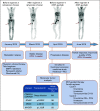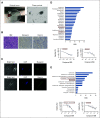Clinical Utility of Functional Precision Medicine in the Management of Recurrent/Relapsed Childhood Rhabdomyosarcoma
- PMID: 34738048
- PMCID: PMC8563073
- DOI: 10.1200/PO.20.00438
Clinical Utility of Functional Precision Medicine in the Management of Recurrent/Relapsed Childhood Rhabdomyosarcoma
Conflict of interest statement
Maggie Fader Employment: Kidz Medical Services, Inc Travel, Accommodations, Expenses: Kidz Medical Services No other potential conflicts of interest were reported. Maggie Fader Employment: Kidz Medical Services, Inc Travel, Accommodations, Expenses: Kidz Medical Services No other potential conflicts of interest were reported.
Figures



References
-
- Ray A, Huh WW: Current state-of-the-art systemic therapy for pediatric soft tissue sarcomas. Curr Oncol Rep 14:311-319, 2012 - PubMed
-
- Letai A: Functional precision cancer medicine-moving beyond pure genomics. Nat Med 23:1028-1035, 2017 - PubMed
-
- Kodet R: Rhabdomyosarcoma in childhood. An immunohistological analysis with myoglobin, desmin and vimentin. Pathol Res Pract 185:207-213, 1989 - PubMed
Publication types
MeSH terms
LinkOut - more resources
Full Text Sources
Medical

